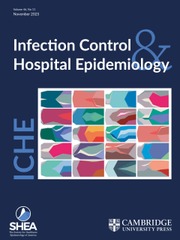No CrossRef data available.
Article contents
Statistics and Meaningful Infection Rates
Published online by Cambridge University Press: 21 June 2016
Abstract
An abstract is not available for this content so a preview has been provided. As you have access to this content, a full PDF is available via the ‘Save PDF’ action button.
Information
- Type
- Departments
- Information
- Copyright
- Copyright © The Society for Healthcare Epidemiology of America 1992
References
1.
Centers for Disease Control. Nosocomial infection rates for interhospital comparison: limitationsand possible solutions. Infect Control Hosp Epidemiol.1991;12:609–621.Google Scholar
2.
Birnbaum, D. Nosocomial infection surveillance programs. Infect Control. 1987:8:474–479.Google Scholar
3.
Birnbaum, D. Analysis of hospital infection surveillance data. Infect Control. 1984;5:332–338.Google Scholar
4.
Muench, H. Catalytic Models in Epidemiology. Boston, Mass: Harvard University Press; 1959.Google Scholar
5.
Birnbaum, D. Hepatitis B serologic markers-incidence vs prevalence in relation to vaccination policy. Canada Diseases Weekly Report. 1984;10:58–59.Google Scholar
6.
Osterholm, MT, Garayalde, SM. Clinical viral hepatitis B among Minnesota hospital personnel-results of a 10-year survey. JAMA. 1985;254:3207–3212.Google Scholar
7.
Hadler, SC, Doto, IL, Maynard, JE, et al. Occupational risk of hepatitis B infection in hospital workers. Infect Control. 1985;6:24–31.Google Scholar
8.
Wormser, GE
Rabkin, CS, John, C. Frequency of nosocomial transmission of HIV infection among healthcare workers. N Engl J Med. 1988;319:307–308.Google Scholar
9.
McKinney, WP, Young, MJ. The cumulative probability of occupationally acquired HIV infection: the risks of repeated exposures during a surgical career. Infect Control Hosp Epidemiol. 1990;11:243–247.Google Scholar
10.
van Griethuysen, AJA, Chavigny, KH, Grimson, R. Catalytic models in hospital epidemiology. Infect Control. 1983:4:429.Google Scholar
11.
Lee, ET. Statistical Methods for Survival Data Analysis. Belmont, Calif: Lifetime Learning Publications; 1980.Google Scholar

